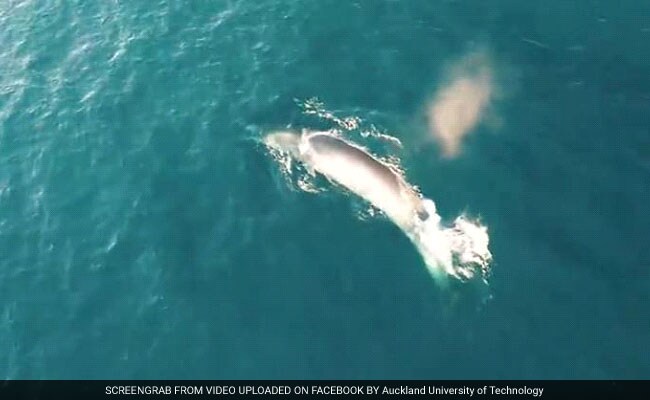Wellington, New Zealand:
New Zealand researchers have captured stunning drone footage of endangered whales feeding off the Auckland coast, giving an unprecedented insight into the majestic giants of the sea.
In a world-first use of drone technology, the researchers dispatched a customised "eye in the sky" so they could observe the rare Bryde's whales without disturbing them.
The resulting footage shows an adult and calf frolicking in the water and using a "lunge" feeding technique to feast on plankton and shoals of small fish.
The adult, a grey behemoth measuring 12 metres (40 foot) long, turns sideways and swims just under the surface, opening its huge mouth to funnel in food.
As it powers forward, the rush of oncoming water expands the underside of its mouth so it balloons out allowing it to fit in more food.
 "Never before have I seen anything like this," Auckland University of Technology (AUT) ecologist Barbara Bollard-Green said.
"Never before have I seen anything like this," Auckland University of Technology (AUT) ecologist Barbara Bollard-Green said.
"There's no way we would see so much detail from a boat-based survey."
Bryde's whales are listed as critically threatened in New Zealand, with less than 200 remaining in the South Pacific nation's waters, and about 100,000 worldwide.
Their preference for feeding just below the surface makes them vulnerable to being hit by ships, particularly in the busy waters around Auckland.
The AUT researchers say that using drones allows them to study marine mammals while keeping their distance.
The waterproof aircraft used to film the whales was 40 metres from them at all times, with the researchers' boat about 1.5 kilometres away.
Lorenzo Fiori, one of the PhD students who took the footage, said it was still a thrill to get a close-up look at the whales.
"It was pure excitement when I was filming and it's simply a joy to watch every time I see it," he said.
In a world-first use of drone technology, the researchers dispatched a customised "eye in the sky" so they could observe the rare Bryde's whales without disturbing them.
The resulting footage shows an adult and calf frolicking in the water and using a "lunge" feeding technique to feast on plankton and shoals of small fish.
The adult, a grey behemoth measuring 12 metres (40 foot) long, turns sideways and swims just under the surface, opening its huge mouth to funnel in food.
As it powers forward, the rush of oncoming water expands the underside of its mouth so it balloons out allowing it to fit in more food.

The waterproof aircraft used to film the whales was 40 metres from them at all times.
"There's no way we would see so much detail from a boat-based survey."
Bryde's whales are listed as critically threatened in New Zealand, with less than 200 remaining in the South Pacific nation's waters, and about 100,000 worldwide.
Their preference for feeding just below the surface makes them vulnerable to being hit by ships, particularly in the busy waters around Auckland.
The AUT researchers say that using drones allows them to study marine mammals while keeping their distance.
The waterproof aircraft used to film the whales was 40 metres from them at all times, with the researchers' boat about 1.5 kilometres away.
Lorenzo Fiori, one of the PhD students who took the footage, said it was still a thrill to get a close-up look at the whales.
"It was pure excitement when I was filming and it's simply a joy to watch every time I see it," he said.
Track Latest News Live on NDTV.com and get news updates from India and around the world

